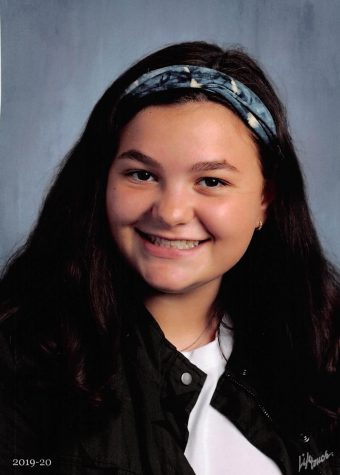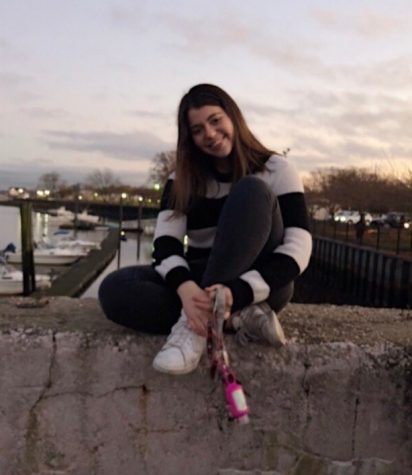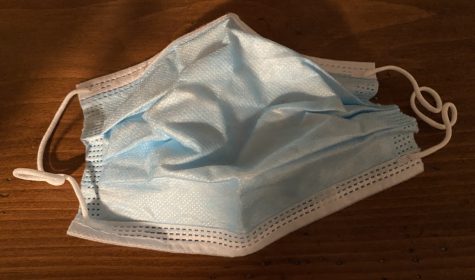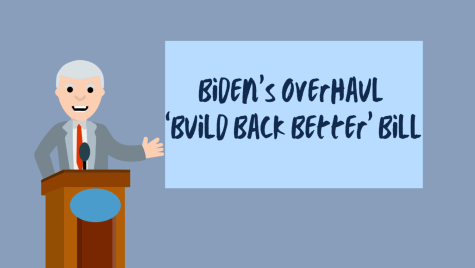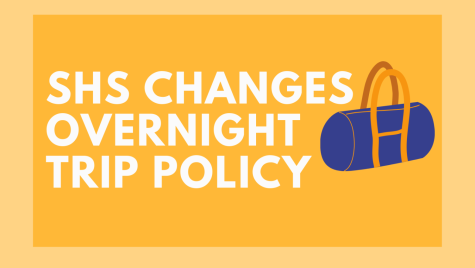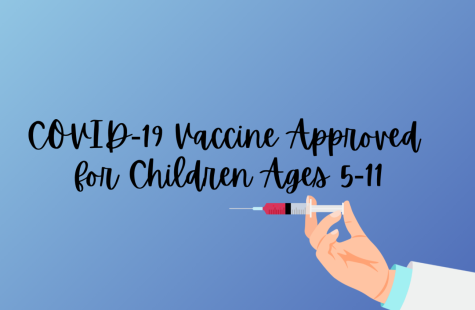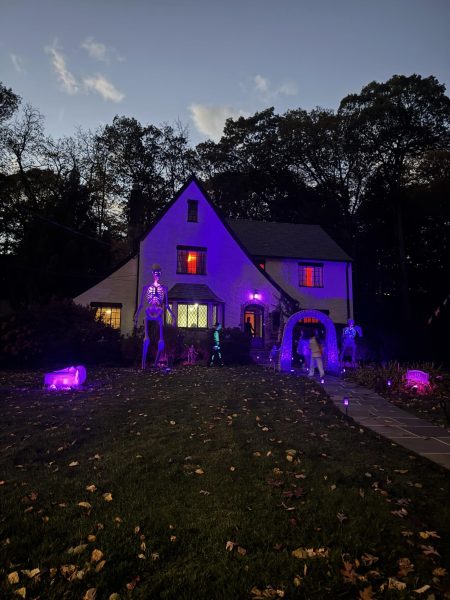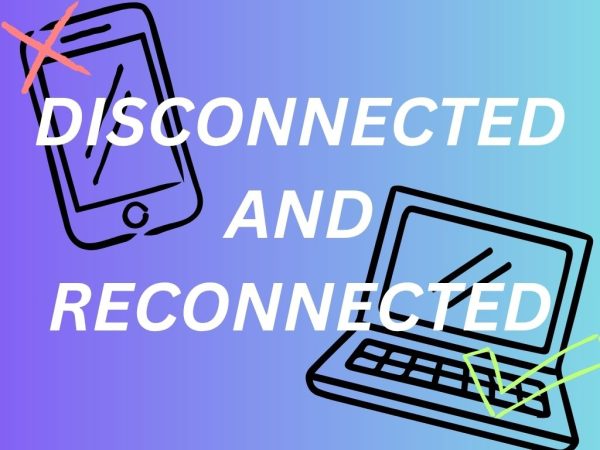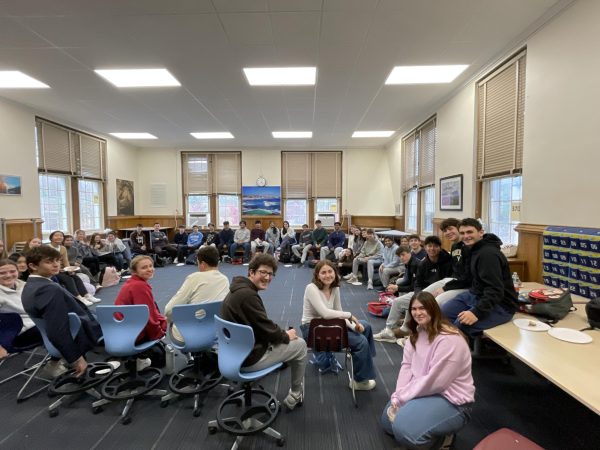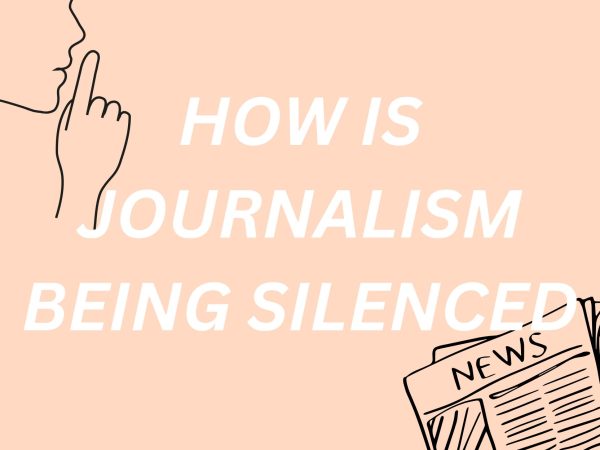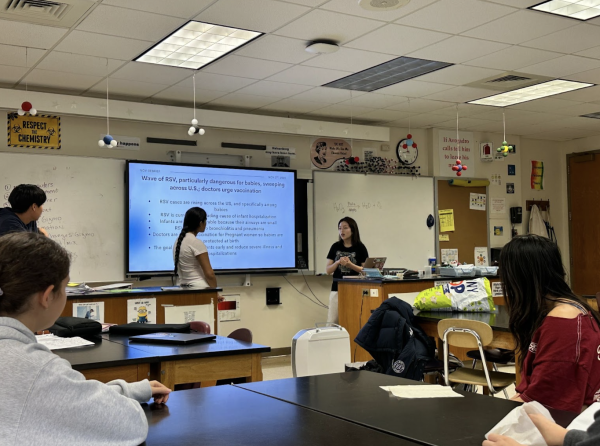Home Cohort Synchronous Engagement Featuring Dr. Drew Patrick Pandemic Podcast Ep. 5
Episode 5 of the pandemic podcast features a conversation with Dr. Drew Patrick, Assistant Superintendent for Human Resources and Leadership Development about the recently released plans for cross-cohort streaming, also referred to as home cohort synchronous engagement. To check out some of our earlier podcasts, go to SHSMaroon.org or download our app from the student new source.
Maroon: So first of all, how are you? — obviously, this is a very stressful time. So assuming you’re very busy right now.
Dr. Drew Patrick: Yes, certainly, been busy, but thank you for asking. I appreciate that. It’s
certainly one of the more — probably the most trying time for all of us.
M: Can you just explain a little bit the whole concept of the cross-cohort streaming and what the purpose is?
D: Yes. I mean, I’ll do the best I can. I think what we’re seeking is a balance of synchronous engagement with all students. And we know we have sort of 3 different modes. We have the times when you’re in school, the times when you are at home, and both of those would be if you’re part of a hybrid cohort. And then we know we have students who are at home, either all the time or for a chunk of time because they’re either quarantined or sick or something like that. So we’re trying to find a root strategy, whatever the right word is toward a strong balance of engaging students in all 3 of those models. And a piece that was discussed throughout the planning, but it was not put in place at least at the outset of the hybrid model was engaging all of the students in their at-home days in some way. If you’ll indulge me, I think it’s important for me to say, I’m not a fan of the term live streaming because I think it congers up a single strategy, one way of doing it, which is essentially turning a camera on and hoping for the best. My view, my belief is that teaching and learning benefits from deep and thoughtful planning on the part of the teacher and then just as deep and thoughtful response and anticipation of what students need in the setting on their feet in the moment. So we’ve intentionally tried — I have intentionally tried to use the phrase home cohort synchronous engagement. I know it’s a mouthful, but that’s intentional because it’s something different than just live streaming. So our hope was to introduce another dimension to the instructional model, the hybrid model on a trial or test basis that’s tailored to individual teachers’ courses and subjects. We’re also in this conversation at the middle school as well, which I know is not necessarily your purview, but it is important in there. There’s actually a distinction being made, whereas we feel pretty strongly that the middle school age students, especially the younger middle school students also need some clear start and stop guidelines to a daily schedule.
M: Definitely. And is there going to be an impact on the current Wednesday schedule if we were to proceed with the at-home synchronous engagement method?
D: Not right now. We — this is independent of what the Wednesday schedule is right now.
M: Got it. Okay. And then maybe just for those of our listeners who might not know, could you give a little bit of background about what your role has been in this decision-making process?
D: Sure. So just my title is Assistant Superintendent for Human Resources and Leadership Development. That doesn’t actually help to answer your question, probably. So I think I played 2 roles. I play a broad and general role as part of the district cabinet. So I’m part of the superintendent’s cabinet, which is a team of leaders who are trying to make thoughtful decisions, especially where they impact multiple schools because obviously, there’s a school administration that is centered on the needs of that particular school, but where we have broader than 1 school, the district administration gets involved. We do try to — our primary roles are to try to help take care of stuff that enables each school to do what it does, which is help students learn. But in this time, we’re all collaborating together to figure out what this is and what this should be and what this isn’t and so forth. So I’m in this general group of us who are helping to lead and make decisions. But I am also the person in my title is responsible for collective bargaining in the district. So I do the — I’m the principal person on the contract negotiations. And we had a contract with the Teachers Association. And under law, there are certain components of work that require different levels of bargaining of discussion about how this mandate will impact or that change, this mandate, that change, that other condition will impact the work of the teachers under the contract. So probably more than you want to know, but this particular requirement to try this synchronous home cohort engagement falls into a category, we think, a category called impact bargaining. So as the district, we have the right to say this is what instruction needs to look like, but we are compelled to discuss, and we believe in discussing what impact that has on the lives of teachers.
M: Why do you feel that the implementation of the at-home synchronous engagement will be beneficial for students? And also, what would you say to the members of the community who are not in favor and who do not feel that it will be beneficial?
D: Yes. I think, first and foremost, it’s that we’ve never done this, and we don’t really know until we try. I found it hard to take a position that’s defensible to either side of this issue. And I know there are sides, at least, probably more than 2, but at least 2 sides to this. We don’t know what the best hybrid model for learning is because we never imagined having to do this. And we probably wouldn’t design this if — even if we had imagined it, right? It’s not what education, really what we’re familiar with. So we think it’s important to not rule anything out without having some sense of what we’re ruling out. So this is a period of time where we’re trying to determine what can work to help engage — keep students engaged. What I hope to the first part of your question, what I hope this period of time does is give opportunities for students and teachers together to figure out ways to maximize or make the best use of the time spent at home on your home cohort days. And we’ve added to the tool kit, a tool, which is engaging through the technology during those times. What we’re not doing is saying what it needs to look like is, turn the camera on and good luck, go for it. It could look at a bunch of different ways. It could be a check-in. It could be a launch of the period. Some days, it might make sense to have a whole group lecture or activity. Other days, it may not — it might not be appropriate. It may allow for some enrichment of the curriculum or even further the coverage of material. In other cases, it may not actually produce that. But we felt the experiment was necessary. That’s probably not the best word for it, but it is a trial period. So I would ask patience for the second part of your question, I would ask patience and trust from those who are against it, which I understand as well, but trust that what we’re doing is going to be thoughtful, and we’re not going to just blindly go ahead with this for the sake of it. That’s not the point.
M: So that’s — yes, that’s a good answer. So going off of what you just spoke about and it being a trial period, some students and some Scarsdale families, members of the community feel like this decision doesn’t really seem like so much of a trial that we just kind of got an e-mail on Thursday after hearing a lot of rumors, smart teachers that this is going to be tried for the next few weeks, and then it’s happening. That’s it. So they feel like their input, their decision — this decision has been made by central administration and no input was given from teachers — or I’m not going to speak on the teachers, but on behalf of students, what would you say to that?
D: That’s not true going forward. The first part of your statement about this is a done deal. It is not. What is a done deal as a period of trial. That is absolutely, and that was put into place without any formal input from students. I can’t deny that. Now is your time. This is the moment as you experience this, with various teachers and various subjects to express what you’re experiencing, how it feels and why you feel it’s a positive or a neutral or a negative. And we’re going to — we’ve encouraged teachers to engage you informally in those inquiries, but we also will have a follow-up formal feedback process to you in the form of a survey. And we’re also — we do have some focus groups going on this week that it might be a little early for this particular topic. But if you did feel strongly, any students in one of those focus groups should share that.
M: Yes. So we actually conducted our own survey to the student body. So, so far, we’ve received about 550 responses from students. And their opinion, in general, has been pretty clear to us in that they very much disagree with the — because I know some teachers have started it already. 86.6% of the 550 responses said that they believe that cross-cohort streaming will have a detrimental effect on their mental health and their general well-being, specifically because there are all of these statistics, which concluded that an increase in screen time will lead to an increase in depressive episodes and it’s — students will be experiencing headaches from staring at their screen all day and also a majority or another majority, but I think it was actually about 25% of students said that already, they are on their — they are having greater than 8 hours of screen time a day. Over 50% said they’re already in this current model, spending over 6 hours, 6 hours Plus. And right now, the current recommendation for screen time is 2 to 3 hours. So we’re already seeing double that right now. So the question really is, how is this going to be beneficial to the mental health and the general well-being of the student body?
D: Obviously, it’s a critically important question. And we have to build in a careful consideration of those potentially predictable or maybe even unintended consequences of a change like this. But let’s step back a little bit, too, and just make sure we’re — I just want to share my thinking on this. So we’re in a moment where all of our decisions are less than optimal. These are — none of these decisions that we’ve all had to make, whether it’s from our end, how we’re going to structure the school day or from year-end, whether you’ve chosen the hybrid model or virtual only. We would not — I said this before, we would not design this in a normal time period. So an increase in screen time seems to be an inevitability to some extent. Now I’d be untruthful if I were saying what we proposed isn’t changing that. Of course, if someone were to take the experiment to its furthest length and turn the camera on, so to speak, at the beginning of every class during the times they’re in person and stream to the home cohort, that would be a significant increase in screen time. But we have not done that yet. So the response to your survey has been perception of what might come, not what is. So what we’re asking for is a trial period to figure out if those predictions are accurate. I am hopeful that the feeling — I hope that you and your peers feel like through this experiment or this trial period, you’ll be empowered to have a voice in what the outcome is. And that, that feeling of — or that being included can bring about a positive feeling of well being, even if it’s also bringing about a challenging feeling as well of the increased screen time. In other words, I think being asked to be part of something is a positive. And without a trial of this, we would never really have that data and that information. We’re part of an experiment. I mean that — it be — wouldn’t be truthful to say otherwise.
M: And as someone who — I mean, I’ve been doing it in my — I’ve been crossover streaming in my history class for, I think, the last 2 weeks. So like I definitely couldn’t have formed the opinions that I formed without that. So I think that definitely a trial period is — it’s necessary. I mean, I agree with having a trial period, I’ll say. So I’ve kind of formed opinions on that. I’m not really — I’m not going to share my opinion is this is kind of more of the student voice, but what would you say to the 87.7% of respondents that feel that utilizing crossover streaming will not better the quality of their education. And as someone who’s tried it, I would have to agree with the majority. Yes. And just to say one more thing about that before you respond, I think that a lot of the concern among the student body is that the school may be more stuck on quantity over quality. I know that an overwhelming majority of the population has said that they find trying to learn over Zoom to be very difficult. It does not work. It’s — some people say it’s a waste of time. They’re only learning when they’re in person or doing asynchronous work. They can’t focus. They can’t comprehend. They can’t engage. And so that’s the feeling that they’re going — that they are kind of having in their heads going forward with the cross cohort streaming is that the quality will just be honestly awful is what they are thinking.
D: So to that last point, I know there’s a lot to your question here. But to that last point, I would say, if that is what’s evident at the end of this period of trial, then we should act on that. If the evidence suggests, this is not something that’s producing a better outcome for students then it’s not something we should continue with. If we’re truly trying this and truly trying to find a way that is different and better, not different and worse, then we would either be able to identify that or abandon it if it’s not effective. To the broader point of how I would respond to the 86 plus percent of students who say this will be a detriment. Again, you — like, so Ariel, you might know, you’ve had the experience, but that’s my case. That’s my point, which would be to say, let’s find out, let’s give careful input. This might be a little bit of an exaggeration, but I suspect if we surveyed students “is Homework good?” We might get an overwhelming response that no, it’s not good, yet educationally as educators, we think there is a role for that. And if it’s used carefully and strategically and intellectually in sound ways that homework can be a good thing. It can be a component of the learning model. Like anything, there are nuances. So you might discover one of those students who responded to your survey might discover that their class has struck on a particular way of once or twice a week, they’re going to have a structure where they are on synchronous led. They’re in a small group with someone in the classroom, and they’re engaging in a conversation in some way. I’m making that up, but we might discover something here that does improve the experience. But it will be in small and probably diverse ways. I think again, back to what I said at the top, what is the model we’re talking about, if everyone’s thinking the cameras turned on and that may be exactly what you’ve experienced in social studies. But if the cameras turned on and, hey, good luck, try to keep up, do the best you can, that might not be a good model. Open mind. We need to keep an open mind for the next several weeks, I think.
M: Yes. I think that’s pretty good advice. And just one question, kind of like bringing in what happened over this weekend. There was a coronavirus case at the PSAT this weekend. And now over 80 students are now on 14-day quarantine through Halloween. So they’re being forced to attend online classes all online, of course, they’re virtual students for the next 14 days. So some feel that this kind of goes to show just how limited our in person class experience may be, like everyone has — I don’t want to say PTSD, but if everyone has the worry of like what happened last year happening again this year, like we could all be back on remote again. So some feel that they worry that implementing this new cross cohort streaming is just going to dilute the quality of the little in person class time we might have this year. What can you say to that?
D: I think that’s a real concern that we have to take seriously and wonder about. I think, again, this is also new. But I’ve anecdotally, I’ve had conversations with teachers who are incredibly surprised at how much they’ve been able to accomplish when only 10 or 11 students are in the classroom, like our planning mind, and I was a high school science teacher, our planning mind goes to this place of, okay, I’m planning for a regular class of kids, I’m doing this. And we’ve never experimented with 10 or 11 in the class and suddenly, wait, I have to readjust my plan because I’m getting through more concepts and discussions, and I’m able to check for my students’ understanding more quickly because there are fewer students. I think all those things are being discovered and adjusted right now. I can’t say that officially, for sure, we know 100% that that’s resulted in a definite change, but I am hearing that that’s a — I’d be interested to know if you’ve experienced that.
M: Yes, definitely. So what you’re saying on the small group classes, that sort of thing, that beneficial sort of thing, wouldn’t cross cohort streaming or at home cohort engagement, wouldn’t that just increase the number of students in the — so like a smaller number of students in a class might increase the amount of material being able to be covered because a teacher can give more attention to that small group, and that can — they can move forward faster. But if they’re focusing on these ten in class and then also the 10 online, doesn’t that kind of remove that efficiency from this process?
D: Yes. I think that’s a possible outcome of that. Yes. I think it’s something we have to really be careful of. And I expect some of what we hear back from both students and faculty members will be when I tried this, here’s what didn’t work. When I tried that, here’s what seemed to go better. I think those are the — that’s kind of the format I expect to hear. The feedback — but in your example, yes, I think that’s a real possible concern.
M: Yes. And I think that, like my opinion, is kind of shaped in what you just said, when we did this, it didn’t work when we did this, it actually did work. So there’s also been a concern with all virtual students. And some of them have expressed through our survey that they feel they will not be getting the same experience that they should be getting because when they are on Zoom, now it won’t just be them, it will be them plus 15 other kids. So they’re not going to have that intimate setting where they are able to be engaged in the in-person learning and be able to ask questions and participate because they’re then going to be kind of lost in the second — the at-home cohort. What would you say about that?
D: That’s something we — from the very beginning of the conversation that I’ve been involved with faculty, they have identified that as a major concern, and I share that concern that I’m just going to restate what you said that the students who are in the dedicated virtual only worry about who now may be able to engage with the class because the teacher only has 1 or 2 students on a screen to have to weave into the classroom instruction, suddenly now has 12 or 13 students to weave in. And yes, we are worried about that. We do think that, that virtual only experience, and I think I can pretty much speak for everybody, but we do want that virtual only experience to feel like a real experience as much as possible. Obviously, it’s not in person, but as much as possible. So we have that as sort of an ethical moral ethical concern. That’s at the top of our list in this period of trial to how is it working for the virtual only students because we don’t want them to I have a sacrifice experience.
M: Right. And so another question that has been circulating is, was the decision to go ahead and do this trial period – was that heavily influenced by one of the earlier Board of Education meetings with the public forum and all of the parents who were very disappointed in the amount of synchronous learning we were getting in comparison to other schools in this county.
D: Yes. I mean, obviously, this is the Scarsdale community school system, right? So the influence and impact of parent voice is important just as student voices. What I will say, though, is we have had an ongoing conversations since restart planning began in the spring about streaming. So the conversation was well underway before that Board meeting. And while the voices that spoke at that meeting raised a variety of different concerns, or I’m going to put it this way; they communicated priorities, their own priorities. Some of those priorities we share, at least theoretically, which is how do we best engage students who are at home. What ultimately, our position was is that we know this is a potential tool in working on that question, engagement of the students who are at home. And we know that lots of people around us, lots of districts around us have been trying this, and we haven’t. And we didn’t really — I don’t feel it’s defensible to the community to say, we know this doesn’t work without actually having tried it. So really, yes, we heard those voices. They — there were some overlapping priorities that they communicated that we were already wondering about and thinking about and the — but the conversations were well underway behind the scenes before that.
M: Got it. And I understand what you’re saying about how we don’t know what cross cohort streaming is going to look like, what the benefits are, what the negatives are to it until we’ve tried it. But what about the arguments of that students don’t learn as well on Zoom as they do in person. And that if you’re in Cohort B, when cohort A is in class and you’re the one zooming in and the teacher — your chemistry teacher is teaching a really difficult complex lesson, and you’re with the 12 students that are online, trying to listen into the lecture, trying to hear the teacher talk, but it’s a little muffled and there are Internet issues and distractions at home. I mean, like we’ve already — we’ve been doing Zoom classes online classes already. We know what the online experience is, and we can compare it to the in-person experience. What would you say to the argument that, on the test, the cohort that was in class is going to — might have an added advantage because they were in class learning the material better because we can — we can already compare the two.
D: That’s a really complex question. There are certainly ways to get at that. If you’re talking specifically about a test, I know there are some teachers who will look at that test performance data with that exact study question in mind and think, okay, does this tell me something about the content that’s learned at home versus the content that’s learned in school? And is it cohort dependent? It just so happened that cohort B was home on the day that, that really pivotal lesson was taught. I mean, those are the kinds of questions I think that we need to tackle in this period of trial. I know I keep going back to that answer, but that’s what it’s for. But yes. I think we’ve learned one thing through all this, is that learning in this format through Zoom or even engaging, whatever that looks like, meetings, things — meetings where you have to make decisions. Your club, Maroon, all of that, it’s all suffering. There’s no doubt that this is suffering from the lack of in person, interpersonal experience. We are ultimately trying to make the best of a bad situation. And it’s hard to have lived in that mode for so long. We’re all in it going on 8 months. But I think we need to be prepared to live in that space for quite a bit longer, trying to make the best of a bad situation.
M: Yes. And so one — another kind of main question circulating, especially in the survey responses is that we’ve just kind of almost finished adapting to this new model. And there have been so many changes within the past 8 months or so. And teachers have finally kind of adapted to the new like having some days where you’re teaching some classes online and vice versa. And people are kind of — people are, in general, very content with the current hybrid model. People aren’t really — I mean, at least from a student perspective, I’ve not heard any students complaining about it. And so the — it kind of goes with that saying, like if it’s not broke, why fix it? So the question is kind of why are we trying to change it when it’s working perfectly fine, at least from a student perspective?
D: Well, I think one answer to your question is that we are — as a school district leader, and I know our principals and the system principals are all in networks, where we meet regularly with our counterparts at different districts around the region. And we are all hearing from each other what seems to be having success and what isn’t having success. And some of what we’re hearing is that this idea or that idea or home cohort engagement is having some success in some places, whereas something else we are doing might be having success that they listen to. So part of what that is, is we are listening and learning and trying to improve what we have. We’re not comfortable as human beings, I think, staying put. I think that’s just our nature as school district leaders. I think on the other hand, it is difficult for people, for humans, to constantly experience change. And I think that’s what you’re reflecting there. There is some peace and solace in the idea of, okay, I understand this. It’s settled, it’s clear. I can count on it. It’s predictable. I get that too. I think these are two forces that are intentioned with one another. The force of familiarity against the force of what if — what if we could be doing something better. And I think that’s what you’re articulating. I can’t say we’re going to stop trying to imagine how it could be better. But I think what we’re doing – the approach we’re taking right now, hopefully, is a guide for us for how to propose potentially other changes as they come forth. That is to try to communicate what it is, how we’re going to go about it, why we think it’s important and then get everybody’s feedback before deciding on whether it gets put into place or not. That’s the best I can answer that.
M: Yes. Got it. We just have one last question about workload. So our question is, I mean, I understand what you were saying before about how middle school students might need more structure to their time. But I mean, high school students, I know for me, I don’t know, I think we talked and feel the same way. When I have my asynchronous learning time when I have my I guess free time, like I have plenty of work to do. I don’t — on my Wednesdays. I know some people are calling them leased Wednesdays or Netflix Wednesdays. It’s November of the college process. Juniors are also studying for their SATs and ACTs. Freshman are busy acclimating to the high school. I don’t feel like I have very much free time like ever, so now that we’re going to have during cross cohort engagement, whatever that looks like we’re going to have less time to do our asynchronous work. Can you — can you ensure that the workload given by teachers will be modified to this less amount of time that we have to do this work?
D: Yes. That’s a critically important point. And I don’t know exactly what the formula or the ratio is. But in so far as you’re being engaged synchronously, that should replace asynchronous work, right? If the asynchronous work is designed to continue your learning in the curriculum during times when you’re not connected to the teacher, that should be a replacement. Right? That should not be in addition to.
M: I’m going to be honest. I mean, I feel like asynchronous work is code word for homework, and I’m just getting a lot of homework. So like I don’t know, I mean, school — if we just have more school, I don’t see how homework could stop. Like I feel like I’m still going to be getting textbook questions for math after we learned the math lesson, and history essays after learning a unit in history. So those are what my concerns are.
D: Right. I mean that’s important feedback to get. But in that, we’re going to have to grapple with and discuss. And I’ll do what I can to make sure that experience is part of the conversation with the faculty. And to the extent you can, if you feel you can share that observation with the teachers, that would be helpful. I mean, we have to — well, I’ll just say for my part, I really operate on the the basic premise that people, all parties involved, students, our faculty, your parents, our Board of Education, everybody is really trying to do the best we can. And it’s — there’s so much unknown that more than ever, it’s critical that we’re communicating with each other. And that in itself is a full time job, like I know it’s a lot to say to you go talk to your teachers about this. It’s hard to find time even to do that. I get that. But we really are in an extraordinary time and the best thing we can do is to try to build in these moments where we say, wait a second, is — does this make sense is what we’re doing making sense. I mean I think the parents you referred to who we heard from at the Board meeting earlier in October, clearly have concerns about their children. Interestingly, they may be different opinions than their own children’s opinions about what works and what. That’s a tough thing for a community to grapple with those differences. It’s going to be rough for a while.
M: Yes. Thank you for answering that. So if there anything else that you would like to add, we invite you to say what we have missed out on.
D: I think you’ve asked very thorough questions, and I appreciate your willingness to get deep on this to really kind of go beneath the surface. I’m grateful for that. Keep doing what you’re doing, keep getting the pulse of the students as best you can. I think you’re doing a great service to your peers. And the adults read what you write and listen to your podcast, too. So you’ve got the audience keep — just keep delivering the work.
M: Thank you. And I’d just like to mention that although there is kind of debate on what is the right thing to do, the whole student body is very grateful. And we obviously recognize all of the hard work and efforts that the administration and all of the teachers and all the faculty has been doing in order to try and make the education that we are receiving the best it can possibly be. So we are very grateful for that. Yes. We all know that you all don’t create these plans for your benefit, like you’re just trying to get us to learn the best that we can, and we really appreciate that.
D: I’m grateful to hear that. That will make my week. I appreciate that.
M: For the Pandemic Podcast, this has been Editors-in-Chief Leah Breakstone and Ariel Weinsaft.

